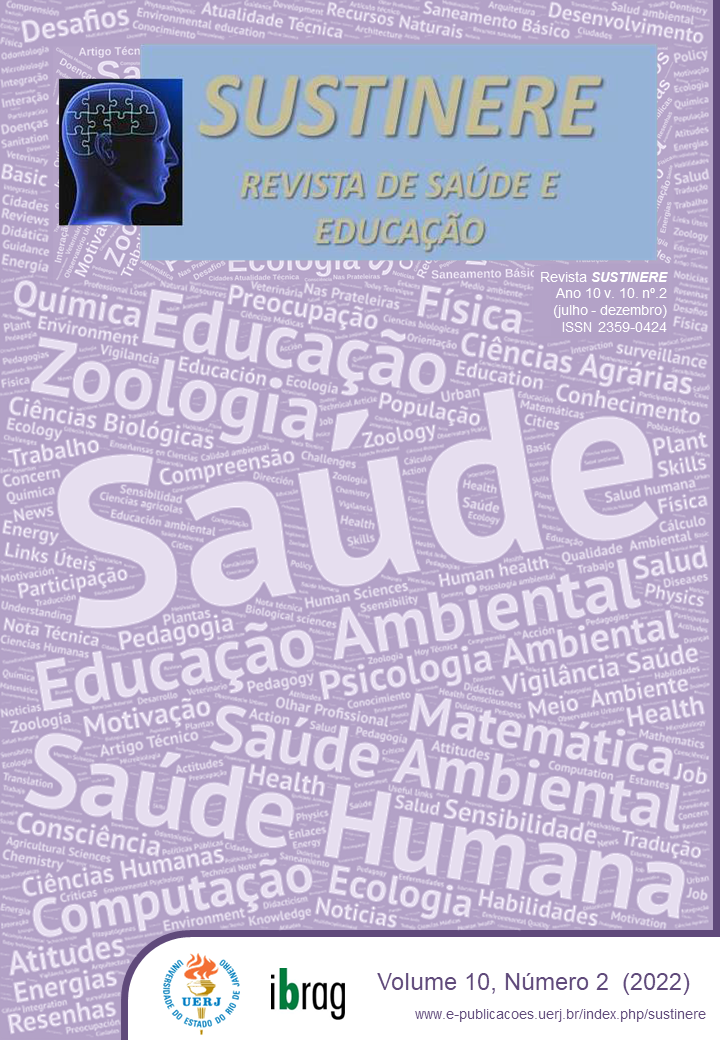Physicochemical characterization of the powder from Eugenia stipitata McVaugh ssp. sororia McVaugh (Myrtaceae) leaf
DOI:
https://doi.org/10.12957/sustinere.2022.51351Keywords:
Araçá-boi, Quality control, Physical and chemical assays.Abstract
Brazilian biodiversity is recognized as one of the most expressive in the terrestrial biosphere. The Eugenia stipitata plant, known as araçá-boi, belongs to the Myrtaceae family composed of more than 130 genera and 4.000 species of green shrubs and trees throughout the year. However, for the plant to be used in medicinal form, there is a need to establish the parameters for the quality control of plant raw material and dry extract. In this sense, the present work aimed to contribute to the physical and chemical study of E. stipitata leaves. The plant was collected in the municipality of Porto Velho-RO, thus making a desiccant that was deposited in a herbarium. The physical-chemical procedures were performed at the Organic Chemistry Laboratory of the Federal Institute of Science and Technology - IFRO, Campus Porto Velho-RO. Qualitative tests for the identification of the main classes of secondary metabolites were based on specific methodologies of Phytochemistry. Later, the extractive solution of the leaves of E. stipitata passed through the relative density, determining the potential of ionic hydrogen (pH). In addition, total ash and the granulometry of the vegetable raw material were determined. The data obtained indicate the presence of groups of substances normally associated with different biological activities and which may justify the medicinal use of the species. In addition, these groups agree with those observed in other species representing the Myrtaceae family. Therefore, future studies are needed that can contribute to obtain relevant information about the standardization and quality control of the raw material of this species.
References
ALHO, C.J.R. Importância da biodiversidade para a saúde humana: uma perspectiva ecológica. Estudos avançados, v.26, p.156-164, 2012.
BRASIL, F.B. 5ª Farmacopeia Brasileira. 5.ed. v. 1. Brasília, ANVISA. 546p, 2010.
COUTO, R.O.; VALGAS, A.B.; BARA, M.T.F.; PAULA, J.R. Caracterização físico-química do pó das folhas de Eugenia dysenterica DC. (Myrtaceae). Revista Eletrônica de Farmácia, v.4, p.59-69, 2009.
FALCÃO, M.A.; GALVÃO, R.M.S.; CLEMENT, C.R.; FERREIRA, S.A.N.; SAMPAIO, S.G. Fenologia e produtividade do araçá-boi (Eugenia stipitata, Myrtaceae) na Amazônia Central. Acta Amazônica, v.30, p.9-21. 2000.
FARMACOPÉIA BRASILEIRA. 2002. 4. ed. Fascículo II. São Paulo: Atheneu Editora LTDA.
LORENZI, H.; MATOS, F.J.A. Plantas medicinais no Brasil: nativas e exóticas. Nova Odessa: Instituto Plantarum. 704p. 2002.
MATOS, F.J. Introdução à fitoquímica experimental. 3.ed. Fortaleza: Edições UFC. 141p. 2009.
MIGLIATO, K.F.; MOREIRA, R.R.D.; MELLO, J.C.P.; SACRAMENTO, L.V.S.; CORRÊA, M. A.; SALGADO, H.R.N. Controle da qualidade do fruto de Syzygium cumini (L.) Skeels. Revista Brasileira de Farmacognosia, v.17, p.94-101, 2007.
QUEIROZ, J.M.G.; SUZUKI, M.C.M.; MOTTA, A.P.R.; NOGUEIRA, J.M.R.; CARVALHO, M.C. Aspectos populares e científicos do uso de espécies de Eugenia como fitoterápico. Revista Fitos, v.9, p.87-100, 2015.
SANTOS, E.V.M. Extração de matérias-primas vegetais. In: SHARAPIN, N. Fundamentos de tecnologia de Produtos Fitoterápicos. Santafé de Bogotá: Cyted. 60p. 2000.
SANTOS, V.A.; RAMOS, D.R; TOSTES, N.V.; SILVA, F.O.R.; ALMEIDA, L.G.F. Caracterização física e química de frutos de araçá-boi (Eugenia stipitata McVAugh) em Lavras-MG. Centro Científico Conhecer, v.14, p.167-180, 2017.
SHARAPIN, N. Fundamentos de tecnologia de Produtos Fitoterápicos. Santafé de Bogotá: Cyted, 157p. 2000.
SILVA-JÚNIOR, J.O.C. Obtenção e avaliação de forma farmacêutica semi-sólida fitoterápica contendo extrato seco por nebulização de Simphytum officinale L. (confrei). 2006. Tese (Doutorado em Fármacos e Medicamentos), Universidade de São Paulo. 2006.
SOUZA-MOREIRA, T.M.; SALGADO, H.R.N.; PIETRO, R.C.R.L. O Brasil no contexto de controle de qualidade de plantas medicinais. Revista Brasileira de Farmacognosia, v.20, p.435-440, 2010.
SOUZA, V.C.; LORENZI, H. Botânica sistemática: guia ilustrado para identificação das famílias de Fanerógamas nativas e exóticas no Brasil, baseado em APG III. Nova Odessa: Instituto Plantarum, 704p. 2014.
WHO, World Health Organization. Monographs on selected medicinal plants, v.2, Geneva., 2002.
Downloads
Published
How to Cite
Issue
Section
License
Copyright (c) 2022 Revista Sustinere

This work is licensed under a Creative Commons Attribution 4.0 International License.
The copyright of the articles published in the Journal belong to Revista SUSTINERE your (s) in question (s) author (s), with first publication rights granted to the Revista SUSTINERE.
The published articles are publicly accessible, free to use, with mandatory assignment of original authorship, according to the licensing model Creative Commons 4.0 adopted by the magazine.






